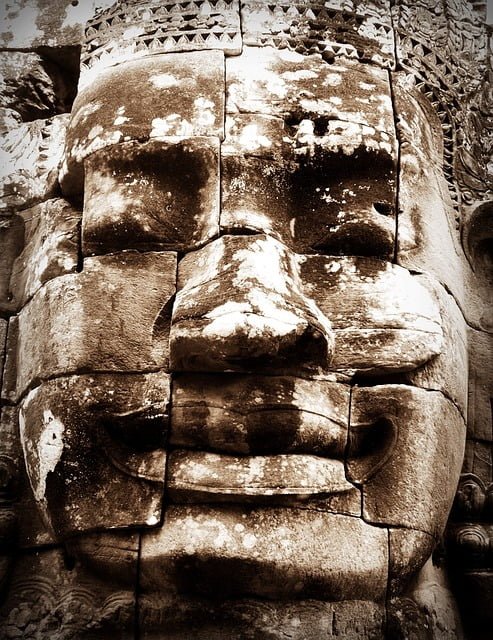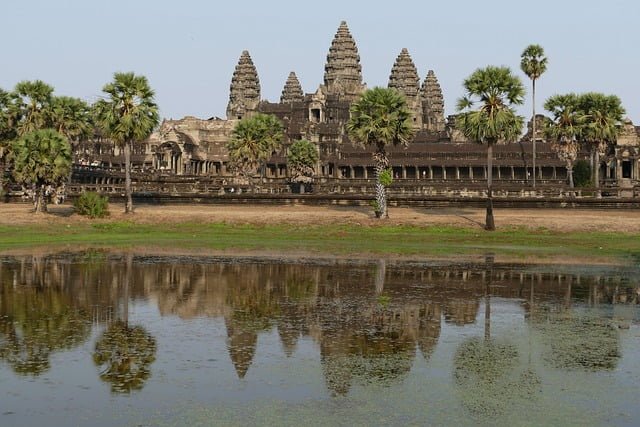Table of Contents
Angkor Wat, the 8th Wonder of the World, is a temple complex located in the heart of Cambodia, near the town of Siem Reap. This architectural masterpiece, built in the 12th century, is not only a major tourist attraction but also a symbol of the rich cultural heritage of the Khmer Empire. With its intricate carvings, historical significance, and architectural brilliance, Angkor Wat stands as a testament to the artistic achievements of the 8th wonder of the world.
Exploring Angkor Wat: A Historical Perspective

Angkor Wat, the largest religious monument in the world, holds immense historical significance. It was built during the reign of King Suryavarman II, who ruled the Khmer empire in the 12th century. Originally dedicated to the Hindu deity Vishnu, the temple complex showcases intricate carvings, temple walls, and bas-reliefs that depict historical events, Hindu gods, and the various capitals of the Khmer Empire.
The Grandeur of the 12th Century Temple Complex
Covering 162.6 hectares, Angkor Wat is a grand temple complex that symbolizes Mount Meru, the home of the gods in Hindu mythology. It is the largest religious structure in the world, leaving visitors awe-struck with its architectural brilliance and intricate carvings. The temple complex, surrounded by a wide moat, reflects the code of conduct of the Khmer people, who built it as a testament to their cultural heritage.
one of the largest & best Hinduism temple
The central temple complex, a testament to the architectural brilliance of the Khmer empire, is dedicated to the god Vishnu, showcasing the historical significance of the 12th century. With intricate carvings, temple walls, and a wide moat, it holds immense cultural significance. As the largest religious monument, it’s the heart of Cambodia, attracting visitors from around the world, and embodying the spirit of the Khmer people.
The Change from Hinduism to Buddhism at Angkor Wat
Angkor Wat, originally a Hindu temple, underwent a major cultural shift and transformed into a major Buddhist temple. This transition is reflected in the intricate carvings of both Hindu gods and Buddhist monks, symbolizing the historical events of the 14th century. Today, the temple complex stands as a UNESCO World Heritage site, embracing both religious beliefs and serving as a cultural emblem of the Khmer Empire’s legacy.
The Architectural Brilliance of Angkor Wat

The architectural marvel of Angkor Wat has earned its place as the eighth wonder of the world, captivating visitors with its intricate design. The temple is part of the Angkor complex, showcasing the ancient Khmer Empire’s grandeur and cultural significance. Constructed in the 9th century by King Jayavarman VII, it stands as a testament to the empire’s glory amidst turbulent times.
Elements of Khmer Architecture in Angkor Wat
Angkor Wat showcases the architectural brilliance of the 12th-century Khmer Empire, with its sandstone blocks, intricate carvings, and bas-reliefs. The temple complex reflects the cultural influence on Cambodian art, featuring architectural elements from various capitals of the empire. It stands as a cultural emblem of the 8th wonder of the world, representing the architectural heritage of the Khmer people.
The Unique Astronomy of Angkor Wat
Angkor Wat is not only known for its architectural brilliance but also for its unique astronomy. The temple complex symbolizes the cosmology of the Khmer empire, with its intricate carvings, architectural designs, and wide moat reflecting the Khmer people’s astronomical knowledge. The historical, cultural, and architectural significance of Angkor Wat showcases the Khmer Empire’s understanding of the cosmos.
The Artistic Wealth of Angkor Wat
Nestled in the heart of Cambodia, Angkor Wat is often dubbed as the “eighth wonder of the world,” boasting exquisite architectural marvels and intricate carvings. The iconic Angkor complex includes the awe-inspiring Angkor Thom, showcasing the artistic prowess of the Khmer Empire from the 9th century. King Jayavarman VII’s legacy is etched within these sacred walls, making it a prominent feature on the list of world heritage sites. The rich artistic heritage of this ancient city rivals Italy’s Pompeii, drawing visitors from across the globe.
Deciphering the Intricate Bas-Reliefs
One of the most captivating features of Angkor Wat is its intricate bas-reliefs, which showcase the cultural significance of the 12th-century Khmer Empire. These carvings depict historical events, Hindu mythology, and the various capitals of the empire, providing a glimpse into the artistic brilliance of the time. Deciphering these carvings is like unravelling the intricate tapestry of the Khmer Empire’s history.
The Artistic Influence on Cambodian Culture
Angkor Wat, with its historical, cultural, and architectural significance, has had a profound influence on Cambodian culture. The temple complex, with its intricate carvings, temple walls, and wide moat, serves as a cultural emblem of the 8th wonder of the world, reflecting the artistic heritage of the Khmer Empire. The carvings of Hindu mythology, Buddhist cosmology, and historical events have influenced the artistic expression of the Khmer people throughout the centuries.
The Cultural and Spiritual Significance of Angkor Wat

The harmonious blend of spirituality and culture at Angkor Wat resonates with visitors. Built-in the 9th century, it holds immense significance as Cambodia’s national symbol, part of a list of world heritage sites, alongside Italy’s Pompeii. The temple complex symbolizes the Khmer Rouge’s triumph over adversity and King Jayavarman VII’s vision. This historical landmark is a testament to human resilience.
An Emblem of Cambodian Identity
Angkor Wat, unofficially titled the 8th Wonder of the World, holds great cultural significance for the people of Cambodia. Built in the 12th century, it stands as a testament to the historical, architectural, and cultural heritage of the Khmer Empire. The temple complex, the largest religious structure, embodies the glory of the empire under the rule of King Suryavarman II. Today, it continues to attract visitors from around the world, who come to witness its intricate carvings, wide moat, and architectural brilliance.
Role in Buddhist Worship
Angkor Wat, being a major Buddhist temple, played a crucial role in the religious life of the ancient Khmer people. While it was originally built as a Hindu temple, it later became a significant emblem of Theravada Buddhism, showcasing the fusion of Hindu and Buddhist mythology. The temple walls, adorned with intricate carvings of Hindu gods, hold religious significance, attracting visitors interested in the historical and spiritual aspects of the site.
Angkor Wat and the UNESCO World Heritage Status

Angkor Wat, a part of the Angkor complex in Cambodia, is listed as a UNESCO World Heritage site. This historic site, built by King Jayavarman VII in the 9th century, includes Angkor Thom and is a must-visit for its cultural and historical significance. The Angkor complex is as significant as Italy’s Pompeii and holds a place as the eighth wonder of the world.
Criteria for Selection as a World Heritage Site
In 1992, Angkor Wat was recognized as a World Heritage site by UNESCO, based on its cultural, religious, and architectural significance. The temple complex, with its historical events, architectural brilliance, and cultural heritage, met the criteria of the UNESCO World Heritage site, preserving the cultural heritage of the 12th century and contributing to the cultural significance of the World Heritage list.
Angkor Wat’s Contribution to World Heritage
The inclusion of Angkor Wat as a world heritage site has led to the preservation of its historical, architectural, and cultural significance, drawing attention to the temple complex’s cultural heritage. The intricate carvings and temple walls play a vital role in preserving the historical, architectural, and religious heritage, contributing to the cultural significance of the UNESCO World Heritage list.
Angkor Wat: The New Wonder of the World

Discover the breathtaking Angkor Wat, reminiscent of Italy’s Pompeii, a 9th-century marvel within the Angkor Complex. This UNESCO World Heritage site, situated in the heart of Cambodia near Phnom Penh, unveils the rich Khmer Rouge history and the majestic King Jayavarman VII. Universally recognized as the “eighth wonder of the world,” it tops the list of world heritage sites.
The Recognition by New7Wonders Foundation
Angkor Wat was officially recognized as the 8th wonder of the world by the New7Wonders Foundation, elevating its historical and cultural significance. This recognition has positioned it as a must-see tourist destination, showcasing the architectural brilliance and cultural heritage of the 12th century. The temple complex continues to captivate tourists, contributing to the growth of Cambodian tourism.
Impact on Cambodian Tourism
Angkor Wat’s designation as the 8th wonder of the world has had a significant impact on Cambodian tourism, attracting visitors eager to explore the temple complex’s historical significance. It has become a cultural and historical hotspot, drawing tourists from all over the world to experience the architectural brilliance, intricate carvings, and cultural heritage of the 8th Wonder of the World.
King Suryavarman II: The Visionary behind Angkor Wat

King Suryavarman II, a visionary ruler, spearheaded the construction of Angkor Wat in the 12th century. His ambition to create a grand temple in honour of Vishnu led to the inception of this architectural marvel within the Angkor complex. The temple’s significance is underscored by its inclusion in the list of world heritage sites by UNESCO. Suryavarman II’s legacy reverberates through time as Angkor Wat remains an emblem of Cambodia’s rich cultural history.
The Reign of Suryavarman II
King Suryavarman II, the ruler of the Khmer Empire during the 12th century, was the visionary behind the construction of Angkor Wat. He commissioned the temple complex, dedicating it to the Hindu deity Vishnu, reflecting his religious beliefs. Suryavarman’s reign marked the peak of the empire’s power and influence, and his architectural legacy continues to be celebrated and studied by historians and scholars.
His Contribution to Khmer Architecture
Suryavarman II’s architectural vision shaped the iconic Angkor Wat temple complex. His design of the temple complex reflects the cultural and religious significance of the Khmer people, with intricate carvings, temple walls, and bas-reliefs serving as a testament to his patronage of the arts. Beyond Angkor Wat, the king’s architectural legacy extends to other temples in the region, showcasing the architectural brilliance of the 12th century.
Conclusion
Angkor Wat stands as a testament to the architectural brilliance and cultural significance of the Khmer Empire. As one of the largest Hindu temples in the world, it showcases the grandeur of a bygone era. Over time, Angkor Wat transitioned from being a Hindu temple to a Buddhist site, showcasing the religious shifts in the region.
The intricate bas-reliefs and artistic wealth preserved within its walls provide a glimpse into the rich history and artistic influence on Cambodian culture. Its recognition as a UNESCO World Heritage Site and inclusion in the list of the New7Wonders of the World further solidify its status as a cultural heritage emblem.
Efforts are being made to ensure the long-term preservation of Angkor Wat, including conservation projects and sustainable tourism practices. As we approach 2023, the significance of Angkor Wat only grows, drawing visitors from around the globe to marvel at its beauty and immerse themselves in its history. To continue exploring the historical heritage click here.
Frequently Asked Questions
What is the history of Angkor Wat?
Angkor Wat is a temple complex in Cambodia and the largest religious monument in the world. It was built in the 12th century by King Suryavarman II as a Hindu temple dedicated to the god Vishnu. Later, it transformed into a Buddhist temple and remains an important cultural and historical site today.
What is the history behind Angkor Wat and why is it considered a cultural heritage emblem?
Angkor Wat, built in the 12th century, holds great historical significance as a cultural heritage emblem. It was constructed by the Khmer King Suryavarman II, and dedicated to the Hindu deity Vishnu. The temple complex showcases intricate carvings, architectural brilliance, and historical events of the Khmer empire’s various capitals. With its cultural and religious significance, Angkor Wat stands as a symbol of Cambodia’s rich heritage.
What are some must-see features of Angkor Wat for tourists visiting the site?
When visiting Angkor Wat, several must-see features shouldn’t be missed. The central temple complex, with its intricate carvings, temple walls, and wide moat, is the most famous and iconic feature of the site. Other notable structures include the Bayon Temple, Ta Prohm Temple, and Banteay Srei Temple, each with its unique architectural significance. Exploring the intricate carvings, sculptures, and historical sites of Angkor Wat is a truly unforgettable experience.
How has Angkor Wat been preserved and maintained over the years?
Angkor Wat has been meticulously preserved and maintained through extensive restoration efforts. The site is managed by the Apsara Authority, which oversees its preservation and conservation. Modern technology, such as LiDAR scanning, has been utilized to ensure the site’s restoration efforts are accurate and effective. Visitors are encouraged to respect the site’s rules and regulations, helping to maintain the temple complex’s historical, architectural, and cultural significance.
Who originally constructed Angkor Wat in the 12th century?
Angkor Wat was originally constructed by the Khmer King Suryavarman II in the early 12th century. As the ruler of the Khmer empire, he oversaw the construction of the temple complex, dedicating it to the Hindu deity Vishnu. Angkor Wat stands as one of the largest religious monuments in the world, showcasing the architectural brilliance of the 12th century and the historical significance of the Khmer Empire.
How was Angkor Wat built?
Angkor Wat, the largest religious monument, was constructed in the early 12th century using sandstone blocks. King Suryavarman II, the ruler of the Khmer Empire, oversaw the intricate construction process, utilizing the architectural brilliance of the empire. It is believed that elephants were used to transport the massive stones, each carefully placed to create the intricate carvings, temple walls, and architectural designs of Angkor Wat.
What title has Angkor Wat recently earned, surpassing Italy’s Pompeii?
Angkor Wat recently earned the title of the world’s top landmark in TripAdvisor’s Travelers’ Choice Awards, surpassing Italy’s Pompeii, which held the top spot previously. This recognition further solidifies Angkor Wat’s significance as the 8th wonder of the world, attracting global attention to the temple complex’s historical and cultural heritage. As one of the most notable tourist destinations, Angkor Wat continues to captivate visitors with its intricate carvings, wide moat, and architectural brilliance.
What does the central temple complex of Angkor Wat represent with its five lotus-shaped towers?
The central temple complex of Angkor Wat, with its five lotus-shaped towers, represents the sacred Mount Meru of Hindu mythology. Each of the five towers symbolizes the five peaks of the mythical mountain, the home of the gods. These architectural features add to the cultural significance of the temple complex, further enhancing the historical, religious, and architectural brilliance of Angkor Wat.




